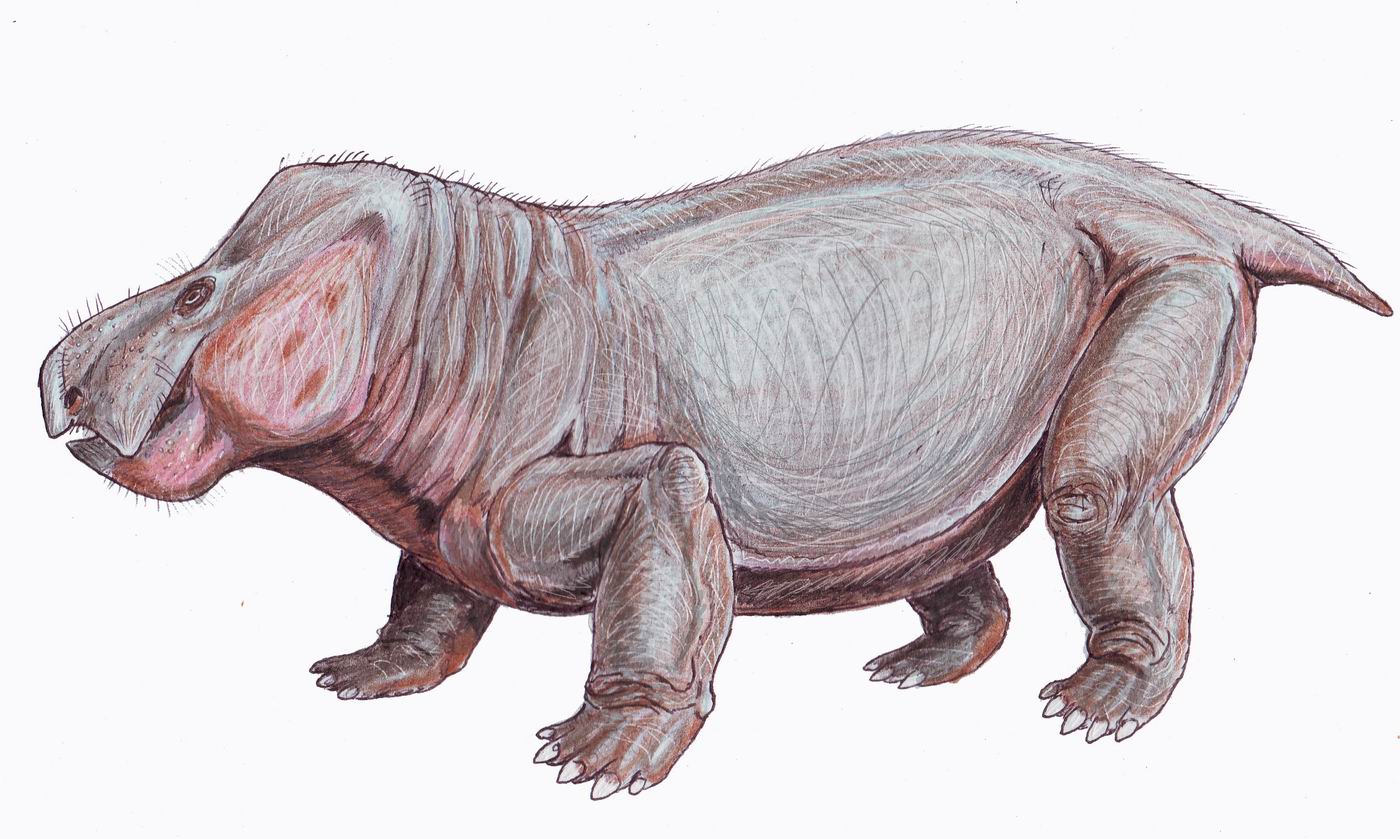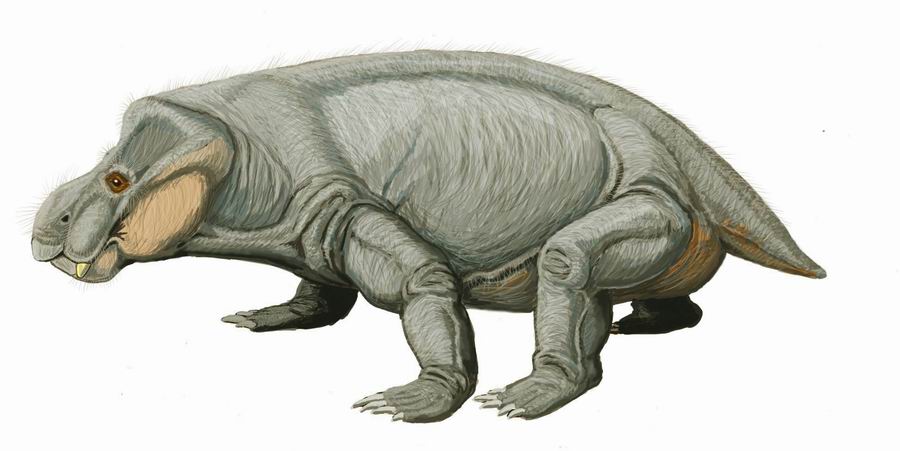|
Rechnisaurus
''Rechnisaurus'' is an extinct genus of dicynodont from the Middle Triassic (Anisian) Yerrapalli Formation of India. It contains a single species, ''Rechnisaurus cristarhynchus''. History ''Rechnisaurus'' has had a long history of confusion with the far more widespread dicynodont '' Kannemeyeria''. ''Rechnisaurus cristarhynchus'' was originally described as a new genus and species in 1970, on the basis of fossils from India. Later in the 1970s, additional specimens were found in Africa (namely the Ntawere Formation of Zambia and the Omingonde Formation of Namibia) and referred to the species. These African fossils were noted to be very similar to ''Kannemeyeria'', so ''Rechnisaurus'' was renamed as a species of ''Kannemeyeria'', ''Kannemeyeria cristarhynchus''. However, in 1989 the original Indian fossils were re-compared to ''Kannemeyeria'' and found to be distinct, so ''Rechnisaurus'' was re-established in a more restricted sense including only the Indian fossils. The Afri ... [...More Info...] [...Related Items...] OR: [Wikipedia] [Google] [Baidu] |
Kannemeyeriidae
Kannemeyeriiformes is a group of large-bodied Triassic dicynodonts. As a clade, Kannemeyeriiformes has been defined to include the species '' Kannemeyeria simocephalus'' and all dicynodonts more closely related to it than to the species '' Lystrosaurus murrayi''. Evolutionary history Despite being the most species-rich group of dicynodonts in the Triassic Period, kannemeyeriiforms exhibit much less diversity in terms of their anatomy and ecological roles than the dicynodonts from the Permian Period. Lystrosauridae is thought to be the most closely related group (sister taxon) to Kannemeyeriiformes, and since the earliest lystrosaurids are known from the Late Permian, the divergence of these two groups must have occurred at least as far back as this time, implying that a long ghost lineage must exist. Although no kannemeyeriiforms have been found in the Late Permian yet, the recent discovery of '' Sungeodon'' helps fill a gap in the early fossil record of the group by showing th ... [...More Info...] [...Related Items...] OR: [Wikipedia] [Google] [Baidu] |
Dicynodontia
Dicynodontia is an extinct clade of anomodonts, an extinct type of non-mammalian therapsid. Dicynodonts were herbivores that typically bore a pair of tusks, hence their name, which means 'two dog tooth'. Members of the group possessed a horny, typically toothless beak, unique amongst all synapsids. Dicynodonts first appeared in Southern Pangaea during the mid-Permian, ca. 270–260 million years ago, and became globally distributed and the dominant herbivorous animals in the Late Permian, ca. 260–252 Mya. They were devastated by the end-Permian Extinction that wiped out most other therapsids ca. 252 Mya. They rebounded during the Triassic but died out towards the end of that period. They were the most successful and diverse of the non-mammalian therapsids, with over 80-90 genera known, varying from rat-sized burrowers to elephant-sized browsers. Characteristics The dicynodont skull is highly specialised, light but strong, with the synapsid temporal openings at the rear of ... [...More Info...] [...Related Items...] OR: [Wikipedia] [Google] [Baidu] |
Yerrapalli Formation
The Yerrapalli Formation is a Triassic rock formation consisting primarily of mudstones that outcrops in the Pranhita–Godavari Basin in southeastern India. The Yerrapalli Formation preserves fossils of freshwater and terrestrial vertebrates as well as trace fossils of invertebrates.Yerrapalli Formation at .org The fauna includes amphibians, [...More Info...] [...Related Items...] OR: [Wikipedia] [Google] [Baidu] |
Kannemeyeria
''Kannemeyeria'' is a genus of dicynodont that lived during the Anisian age of Middle Triassic period in what is now Africa and South America. The generic name is given in honor of Daniel Rossouw Kannemeyer, the South African fossil collector who discovered the original specimen. It is one of the first representatives of the family, and hence one of the first large herbivores of the Triassic. Description ''Kannemeyeria'' was about in length, about the size of an ox. Although it had a large head, it was lightweight due to the size of the eye sockets and nasal cavity. It also had limb girdles which formed massive plates of bone that helped support its heavily built body. ''Kannemeyeria'' was well-adapted to living as a herbivore; it had a powerful beak and strong jaw muscles built for shearing plant material. ''Kannemeyeria'' had a massive head with unusually large openings for the eyes, nostrils and jaw muscles. It evidently tore up roots, stripped leaves from the vegetation ... [...More Info...] [...Related Items...] OR: [Wikipedia] [Google] [Baidu] |
Animal
Animals are multicellular, eukaryotic organisms in the Biology, biological Kingdom (biology), kingdom Animalia (). With few exceptions, animals heterotroph, consume organic material, Cellular respiration#Aerobic respiration, breathe oxygen, have myocytes and are motility, able to move, can reproduce sexually, and grow from a hollow sphere of Cell (biology), cells, the blastula, during embryonic development. Animals form a clade, meaning that they arose from a single common ancestor. Over 1.5 million extant taxon, living animal species have been species description, described, of which around 1.05 million are insects, over 85,000 are molluscs, and around 65,000 are vertebrates. It has been estimated there are as many as 7.77 million animal species on Earth. Animal body lengths range from to . They have complex ecologies and biological interaction, interactions with each other and their environments, forming intricate food webs. The scientific study of animals is known as ... [...More Info...] [...Related Items...] OR: [Wikipedia] [Google] [Baidu] |
Zambia
Zambia, officially the Republic of Zambia, is a landlocked country at the crossroads of Central Africa, Central, Southern Africa, Southern and East Africa. It is typically referred to being in South-Central Africa or Southern Africa. It is bordered to the north by the Democratic Republic of the Congo, Tanzania to the north-east, Malawi to the east, Mozambique to the southeast, Zimbabwe and Botswana to the south, Namibia to the southwest, and Angola to the west. The capital city of Zambia is Lusaka, located in the south-central part of Zambia. The population is concentrated mainly around Lusaka in the south and the Copperbelt Province to the north, the core economic hubs of the country. Originally inhabited by Khoisan peoples, the region was affected by the Bantu expansion of the thirteenth century. Following European colonization of Africa, European colonisers in the 18th century, the British colonised the region into the British protectorates of Barotziland–North-Western Rho ... [...More Info...] [...Related Items...] OR: [Wikipedia] [Google] [Baidu] |
Prehistoric Synapsids Of Asia
Prehistory, also called pre-literary history, is the period of human history between the first known use of stone tools by hominins million years ago and the beginning of recorded history with the invention of writing systems. The use of symbols, marks, and images appears very early among humans, but the earliest known writing systems appeared years ago. It took thousands of years for writing systems to be widely adopted, with writing having spread to almost all cultures by the 19th century. The end of prehistory therefore came at different times in different places, and the term is less often used in discussing societies where prehistory ended relatively recently. It is based on an old conception of history that without written records there could be no history. The most common conception today is that history is based on evidence, however the concept of prehistory hasn't been completely discarded. In the early Bronze Age, Sumer in Mesopotamia, the Indus Valley Civilis ... [...More Info...] [...Related Items...] OR: [Wikipedia] [Google] [Baidu] |
Argentina
Argentina, officially the Argentine Republic, is a country in the southern half of South America. It covers an area of , making it the List of South American countries by area, second-largest country in South America after Brazil, the fourth-largest country in the Americas, and the List of countries and dependencies by area, eighth-largest country in the world. Argentina shares the bulk of the Southern Cone with Chile to the west, and is also bordered by Bolivia and Paraguay to the north, Brazil to the northeast, Uruguay and the South Atlantic Ocean to the east, and the Drake Passage to the south. Argentina is a Federation, federal state subdivided into twenty-three Provinces of Argentina, provinces, and one autonomous city, which is the federal capital and List of cities in Argentina by population, largest city of the nation, Buenos Aires. The provinces and the capital have their own constitutions, but exist under a Federalism, federal system. Argentina claims sovereignty ov ... [...More Info...] [...Related Items...] OR: [Wikipedia] [Google] [Baidu] |
Quebrada De Los Fosiles Formation
Quebrada may refer to: Places Argentina * Quebrada de Las Flechas, a valley in the province of Salta in northern Argentina * Quebrada de Humahuaca, World Heritage, a valley in the province of Jujuy in northern Argentina * Quebrada de Luna, village in Argentina Bolivia * Quebrada Honda, a fossil site in southern Bolivia Brazil * Canoa Quebrada, a seaside resort in northeastern Brazil Chile * Quebrada del Nuevo Reino, a village in Pichilemu, Chile Colombia * Quebrada Limas, a small river in Bogotá Costa Rica * Quebrada Grande, village in Guanacaste, Costa Rica Puerto Rico * Quebrada, Camuy, Puerto Rico, a barrio * Quebrada, San Lorenzo, Puerto Rico, a barrio * Quebrada Arenas, Las Piedras, Puerto Rico, a barrio *Quebrada Arenas, Maunabo, Puerto Rico, a barrio * Quebrada Arenas, San Lorenzo, Puerto Rico, a barrio *Quebrada Arenas, Toa Alta, Puerto Rico, a barrio * Quebrada Arenas, Vega Baja, Puerto Rico, a barrio *Quebrada Arenas, San Juan, Puerto Rico, a barrio * Quebrada ... [...More Info...] [...Related Items...] OR: [Wikipedia] [Google] [Baidu] |
Tanzania
Tanzania, officially the United Republic of Tanzania, is a country in East Africa within the African Great Lakes region. It is bordered by Uganda to the northwest; Kenya to the northeast; the Indian Ocean to the east; Mozambique and Malawi to the south; Zambia to the southwest; and Rwanda, Burundi, and the Democratic Republic of the Congo to the west. According to a 2024 estimate, Tanzania has a population of around 67.5 million, making it the most populous country located entirely south of the equator. Many important hominid fossils have been found in Tanzania. In the Stone and Bronze Age, prehistoric migrations into Tanzania included South Cushitic languages, Southern Cushitic speakers similar to modern day Iraqw people who moved south from present-day Ethiopia; Eastern Cushitic people who moved into Tanzania from north of Lake Turkana about 2,000 and 4,000 years ago; and the Southern Nilotic languages, Southern Nilotes, including the Datooga people, Datoog, who originated fro ... [...More Info...] [...Related Items...] OR: [Wikipedia] [Google] [Baidu] |




